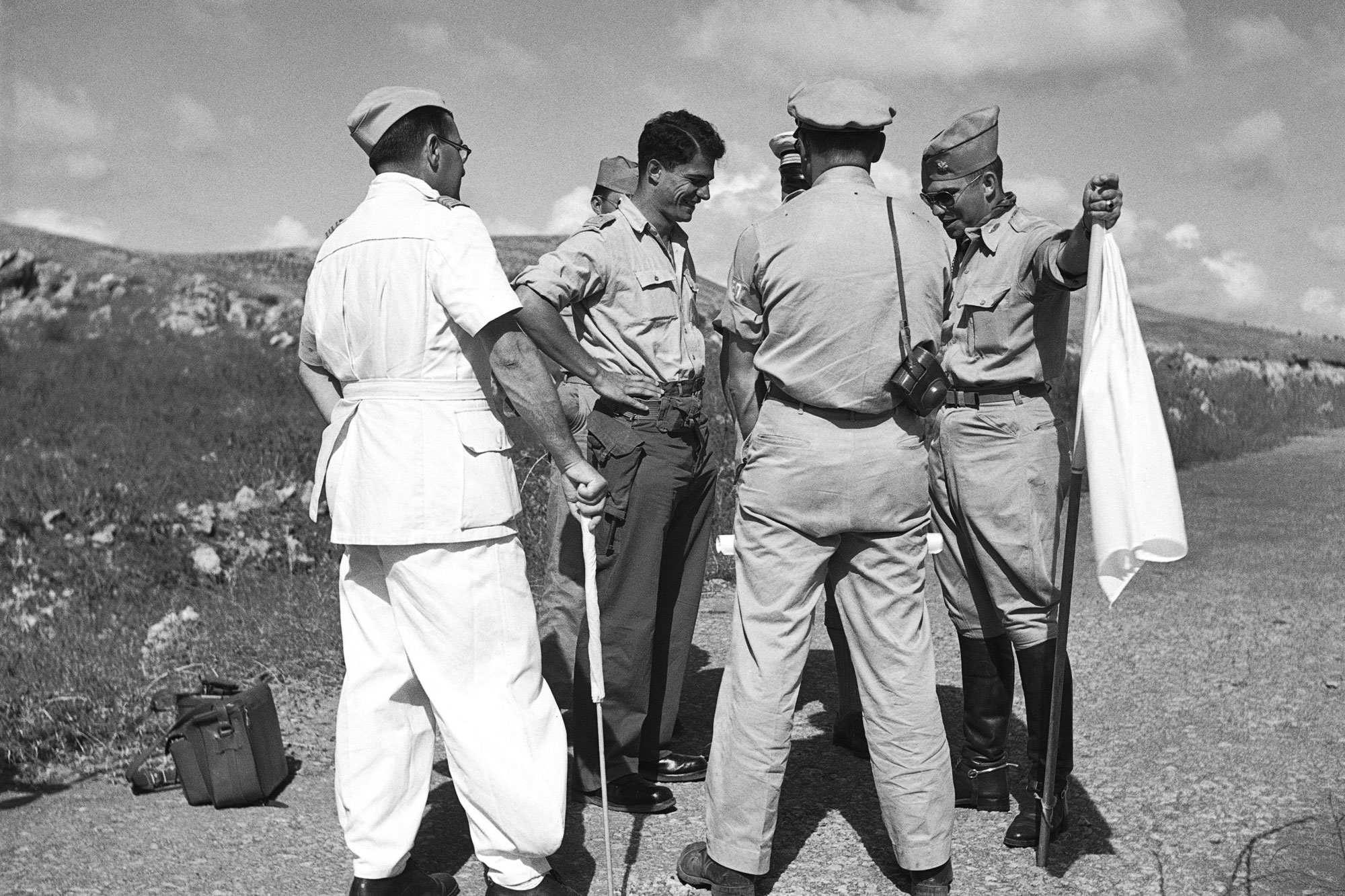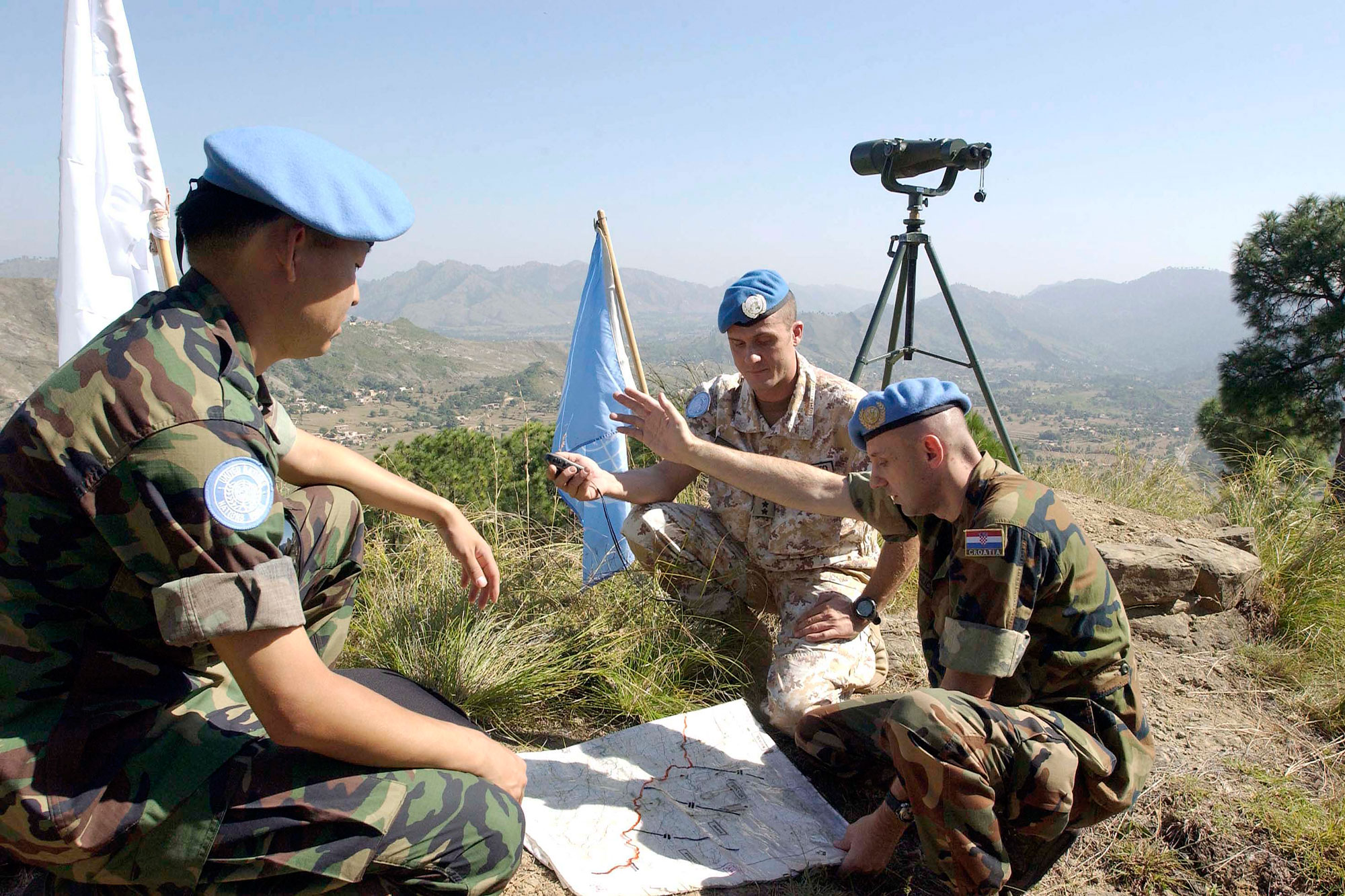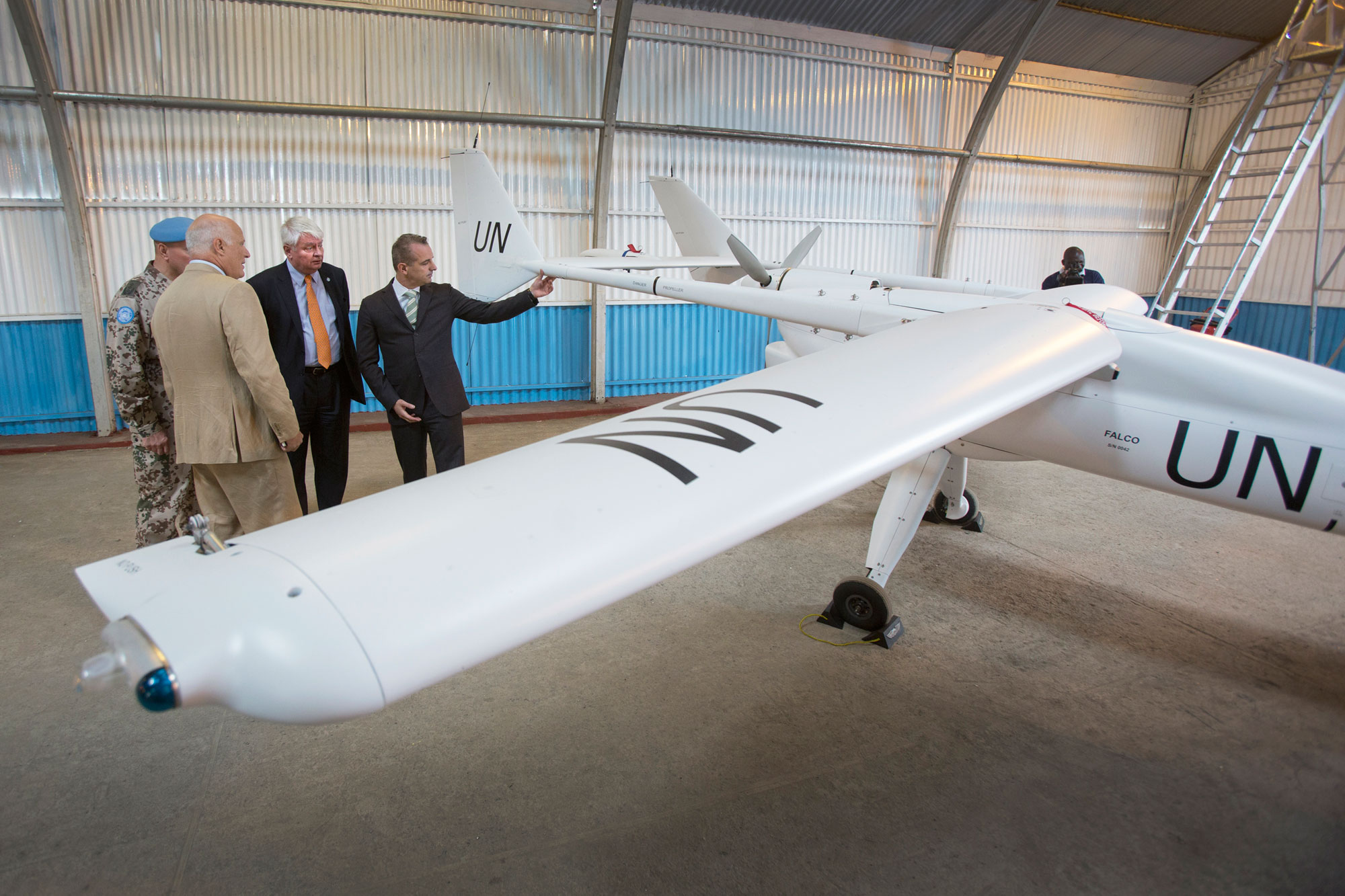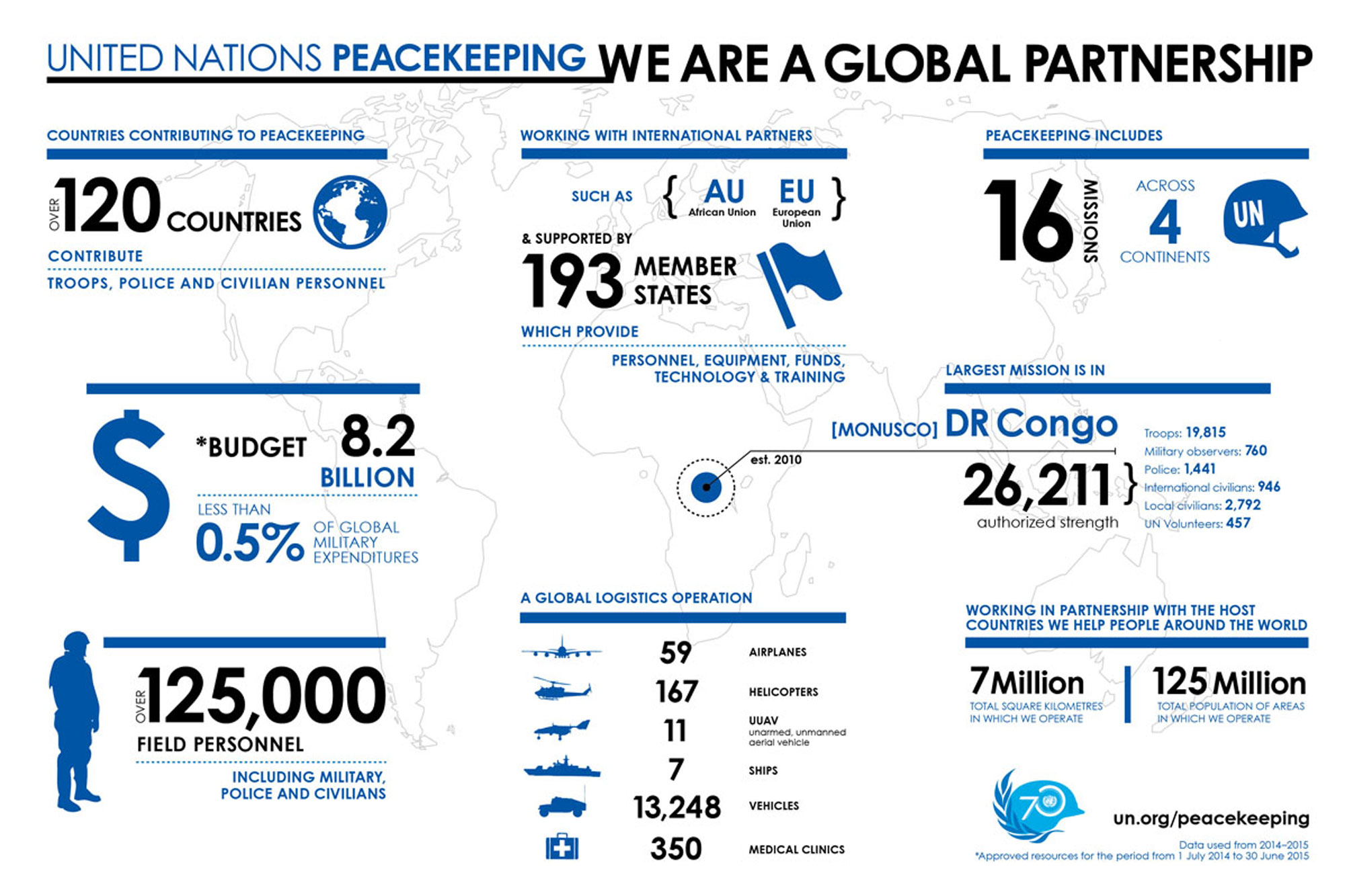FEATURE: From a first mission of 120 unarmed men – UN peacekeeping across the decades
It began when the United Nations was not even three years old, in the fog of the first Arab-Israeli war in 1948, the Organization’s first peacekeeping mission – 120 unarmed men in motley uniforms, not a gun between them, fanning out across scrubby hilltops and desert cliffs to monitor a shaky truce.
Now, as the UN celebrates its 70th birthday, this brittle seed has grown into 71 well-armed forces over the intervening years, comprising hundreds of thousands of troops and police from scores of donating Member States, equipped with unmanned aerial vehicles (UAVs) for reconnaissance and muscular mandates to take the initiative in using force to protect civilians.
Maintaining international peace and security is one of the three principal pillars of the UN edifice, together with promoting development and ensuring the observance of human rights, and the UN Truce Supervision Organization (UNTSO), no geographical marker in its name, was the world body’s very first peacekeeping effort.

Now, the UN Department of Peacekeeping Operations (DPKO) has nearly 125,000 personnel, over 106,000 of them uniformed, from 122 countries, deployed in 16 current operations worldwide, including that very first pioneer set up on 29 May, 1948, and renewed every year since, a sad and ironic commentary on the difficulty of achieving lasting peace.
The past 14 months have been “a pivotal time” for UN peacekeeping, in the words of Under-Secretary-General for Peacekeeping Operations Hervé Ladsous, citing a summit this past September that pledged 40,000 uniformed personnel, and a global chiefs of defence meeting in March that sought to improve operational efficiency.
“We had a world-first this March this year by convening 110 chiefs of staff of armies from around the world,” he told the UN News Centre in an interview. “That had never happened before.
Another first was the peacekeeping summit convened at UN Headquarters in September during the annual high-level segment of the General Assembly.
“The peacekeeping summit gave an opportunity to 54 countries – mostly at heads of State or government level – to pledge a number of things that we badly need, more people to the tune of potentially 40,000 military, police and so on, but also a number of enabling units, equipment that we need, including helicopters, engineering capacities, airlift.”
In the spring Mr. Ladsous created “a strategic force generation unit” to look ahead over the next three to five years at what requirements are going to be and how to adjust these with the offers.
In a glass-enclosed case just outside Mr. Ladsous’s office on the 35th floor of the Secretariat building at UN Headquarters in New York resides the Nobel Peace Prize awarded to UN Peacekeeping Forces in 1988 for making important contributions towards the realization of one of the UN’s fundamental tenets.
“Thus, the world Organization has come to play a more central part in world affairs and has been invested with increasing trust,” the citation said.
It is doubtful that anyone at Lake Success, the UN’s temporary headquarters outside New York City on that distant spring day in 1948, could have foreseen what UNTSO would lead to, not even the then 11-member Security Council which had just set it up to assist a UN monitor in supervising a ceasefire between newly founded Israel and Arab forces in Palestine.
Some 70 military observers, mainly from the United States and Belgium, accompanied by 50 equally unarmed UN guards from Lake Success, began arriving the following month, without the distinctive blue berets or helmets that now distinguish UN forces, giving them the ‘blue helmets’ moniker.
Thus was born the UN role in peacekeeping on the ground, followed in 1949 by the creation of the UN Military Observer Group in India and Pakistan (UNMOGIP) to supervise a ceasefire between those two foes.

The official switch over from observing to peacekeeping did not occur until several years later, and the earliest armed peacekeeping operation, the First UN Emergency Force (UNEF I), was deployed in the Middle East in 1956 to tackle the Suez Crisis, by which time UN military fashion had introduced the blue headgear.
But these earliest pioneers in UN peacekeeping in 1948 faced the same dangers that have seen more than 3,400 peacekeepers from some 120 countries give their lives while serving under the UN flag, either to hostile action, disease or accidents.
Commandant René de Labarrière of France became the first UN peacekeeper to die in the line of duty when his jeep hit a mine on 6 July, 1948. Little over two months later, on 17 September, the mediator himself, Count Folke Bernadotte of Sweden, and an aide were assassinated by Israeli extremists.
DPKO itself did not come into existence until 1992 when the number and complexity of peacekeeping missions required a fully dedicated administration. Before that, the missions were operated through the UN Office of Special Political Affairs.
The UN Operation in the Congo (ONUC), launched in 1960, was the first large-scale ‘blue helmet’ mission, with nearly 20,000 military personnel seeking to hold back the tide of war when the vast country exploded into violence just after gaining independence.
The mission highlighted the risks in trying to bring stability to war-torn regions – a death toll of 250 UN personnel, including then Secretary-General Dag Hammarskjöld, killed in an air crash.
By now the UN had expanded its field operations from military personnel observing ceasefires to complex multidimensional enterprises designed to ensure implementation of comprehensive peace agreements and lay the foundations for sustainable peace, increasingly in cases of civil wars, by helping to build institutions, monitor human rights, reform the security sector, and disarm and reintegrate former combatants.
Although the military remains the backbone of most missions, these enlarged peacekeeping functions also require administrators, economists, police officers, legal experts, de-miners, electoral observers, human rights monitors, civil affairs and governance specialists, humanitarian workers, and communications and public information experts.

Just between 1989 and 1994, the Security Council authorized 20 new missions, raising the number of peacekeepers from 11,000 to 75,000, to enforce ceasefires that had already been agreed and lay the foundations for stability.
By the mid-1990s the Security Council was increasingly mandating under-manned operations to crisis points where the guns were still spitting out death, and there was no peace in fact to keep.
In Rwanda the few hundred troops of the UN Assistance Mission for Rwanda (UNAMIR) were too few to prevent the genocide of up to 800,000 Tutsis and moderate Hutus by Hutu extremists in 1994.
In the former Yugoslavia the few hundred soldiers of the UN Protection Force (UNPROFOR) in Srebrenica were too few to prevent the massacre of up to 8,000 Muslim men and boys by Bosnian Serbs in 1995.
As for Somalia, the country was so riven by warring factions that there was no way the UN Operation in Somalia II (UNOSOM II) in 1993 could fulfil its mandate “to take appropriate action, including enforcement measures, to establish throughout Somalia a secure environment for humanitarian assistance,” completing through disarmament and reconciliation the task begun by an earlier mission. It was withdrawn two years later.
It was time for the Security Council and DPKO to learn from these lessons, with investigations held into all three, culminating in 2000 in the so-called Brahimi Report, named after veteran diplomat Lakhdar Brahimi, Chair of the Panel that produced it.
It called for renewed political commitment on the part of Member States, significant institutional change and increased financial support to ensure that ‘blue helmets’ were never again put into such untenable situations.
Since then UN peacekeeping missions have achieved some notable successes, sometimes alone, sometimes with Member States as partners, as they confront an increasingly varied number of calls for help, from Kosovo to South Sudan and from Haiti to Timor-Leste.
They have brought relative stability to seemingly intractable issues, often with proactive mandates strengthened for a wider use of force if necessary, especially in the protection of civilians.
In Liberia they pacified a seemingly interminable and brutal civil war, ensuring the demobilization and reintegration of former foes and presiding over a series of democratic elections. In Timor-Leste they shepherded a new nation to independence from Indonesia.
In Côte d’Ivoire, together with French forces, they ended an increasingly bloody outbreak of violence when the incumbent president ignored his electoral loss.
In the current conflict in the Central African Republic (CAR), they are increasingly performing police functions, with the power to arrest in Bangui, the capital, where order has broken down.

Nor are they slouches in the technology field, increasingly using UAVs for surveillance, intelligence and the protection of civilians, though for November’s visit by Pope Francis to Bangui, where they ensured security, UN personnel resorted to less high-tech equipment, using tethered balloons with an array of cameras and sensors.
“[This] enabled us to have a real-time view of the whole capital, see demonstrations as they are taking shape and therefore being able to act without delay,” said Mr. Ladsous, who stressed the changing aspects of the missions.
“One of the greatest challenges has to do with the protection of civilians,” he stressed. “This is the heart of most of the missions of the last 10 or 12 years – a pro-active, dynamic, robust posture, particularly in the Democratic Republic of Congo (DRC), to neutralize armed groups.”
In the DRC, where the UN has been present under different names since the ONUC mission over 50 years ago, the current UN Organization Stabilization Mission (MONUSCO), with nearly 20,000 uniformed personnel, has a particularly proactive mandate.
It is endowed with a specialized “intervention brigade” of three infantry battalions, one artillery and one special force and reconnaissance company mandated to neutralize armed groups to re-establish state authority and protect civilians in the apparently endless conflicts shaking the eastern part of the vast country.
Though the UN has no army of its own, with both commanders and troops coming from contributing countries, it has to foot the bill, again by seeking Member State contributions, at no small cost: the budget for the year beginning 1 July, 2015 is $8.27 billion.

Mr. Ladsous also stresses the changing nature of conflicts where non-State actors are rising to the fore. “We’re not dealing with governments, but mostly with non-State actors including terrorist and jihadist groups and transnational criminals. So it requires a major change in the way we operate,” he said.
He highlighted the need to invest in technology, intelligence and information gathering “because if you want to survive a terrorist environment like Mali you need that information.
“We are not a tool against terrorists… but we are targets and we have to put a lot of effort in being able to face that. We are not an anti-terrorist tool; in the north of Mali that task has been entrusted by the Council to the French, but we have to be able to do the job in that ambience.”
As for that very first operation set up 67 years ago, its functions have changed from time to time in light of changing circumstances, as after the 1956, 1967 and 1973 wars, with its observers acting as go-betweens for the hostile parties and as a means to contain isolated incidents from escalating into major conflicts.
Today groups of UNTSO observers are attached to peacekeeping forces in the area: the UN Disengagement Observer Force (UNDOF) in the Golan and the UN Interim Force in Lebanon (UNIFIL), while a group of observers remain in Sinai to maintain a UN presence there.
As of 30 June it had grown to 142 military observers, 89 international civilian personnel and 146 local civilian staff. Its death toll has grown over the years, too, to 50 – 18 troops, 18 military observers, eight international civilians and six local civilians.
UNTSO observers are still patrolling some of those very same hills their predecessors did in 1948 along the lines between Israel and Lebanon – but this time with blue headgear.
Major-General Arthur David Gawn of New Zealand, a veteran of UN operations in Bosnia and Herzegovina and Timor-Leste, now presides over the force at its headquarters in Jerusalem atop the Hill of Evil Counsel – thus named since Byzantine tradition identifies it as the place where High Priest Caiphas and his colleagues decided to arrest Jesus.
As for heading the UN’s very first peacekeeping operation, he notes that his connections with the area go way back before 29 May, 1948. “Beer Sheba (Israel), the whole of the Palestine area, even Egypt, that’s where my grandfather fought, a long time ago, in the camel corps (in the First World War),” he told the UN News Centre.

